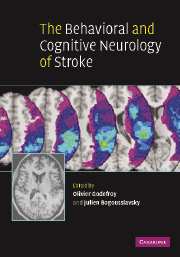Book contents
- Frontmatter
- Contents
- Contributors
- Preface
- 1 Evaluation of cognitive and behavioral disorders in the stroke unit
- Motor and gestural disorders
- Aphasia and arthric disorders
- Hemineglect, Anton–Babinski and right hemisphere syndromes
- Agnosia and Bálint's syndrome
- Executive and memory disorders
- Behavioral and mood disorders
- 22 Akinetic mutism and related disorders
- 23 Alterations of level of consciousness related to stroke
- 24 Delirium and confusional state in stroke patients
- 25 Post-stroke delusion
- 26 Acute behavioral and mood changes
- 27 Stroke and personality change
- 28 Post-stroke mania
- 29 Depression after stroke
- 30 Fatigue
- Dementia and anatomical left/right syndromes
- Index
- References
27 - Stroke and personality change
Published online by Cambridge University Press: 10 October 2009
- Frontmatter
- Contents
- Contributors
- Preface
- 1 Evaluation of cognitive and behavioral disorders in the stroke unit
- Motor and gestural disorders
- Aphasia and arthric disorders
- Hemineglect, Anton–Babinski and right hemisphere syndromes
- Agnosia and Bálint's syndrome
- Executive and memory disorders
- Behavioral and mood disorders
- 22 Akinetic mutism and related disorders
- 23 Alterations of level of consciousness related to stroke
- 24 Delirium and confusional state in stroke patients
- 25 Post-stroke delusion
- 26 Acute behavioral and mood changes
- 27 Stroke and personality change
- 28 Post-stroke mania
- 29 Depression after stroke
- 30 Fatigue
- Dementia and anatomical left/right syndromes
- Index
- References
Summary
Introduction
Personality is defined as a distinctive constellation of relatively stable behaviors, thoughts, motives, and emotions that characterize a unique individual. Personality organization derives from the interaction between the individual and social learning as well as an internal set of motivated predispositions to respond. Cloninger et al. (1993) have developed a biosocial model of personality describing four dimensions of temperament genetically dependent and stable and three dimensions of character that are influenced by social learning. The four dimensions of temperaments include:
novelty seeking, describing genetic dispositions towards being excitable, impulsive, exploratory, and quick-tempered
harm avoidance, related to behavioral inhibition, implying a heritable bias towards being cautious, apprehensive, and pessimistic
reward dependence, involving the maintenance of behaviors previously associated with reinforcement
persistence, describing the ability to persevere despite fatigue or lack of reward.
The three dimensions of character are:
self-directedness, implying an autonomous self-concept and feelings of hope and self-confidence
cooperativeness, involving identification with and acceptance of others, and compassion
self-transcendence, related to spirituality, patience, and self-forgetfulness.
Cloninger et al. (1993) hypothesized that each temperament dimension is regulated neurochemically by a complex distributed network of brain connections. Novelty seeking has been associated with dopaminergic activity, harm avoidance with serotonergic activity, and reward dependence with noradrenergic activity. Youn et al. (2002) observed that each temperament dimension is correlated with regional cerebral glucose metabolism in specific areas of paralimbic regions and temporal lobes. These findings provide further evidence that temperament dimension is associated with specific brain areas and neurotransmitters.
Information
- Type
- Chapter
- Information
- The Behavioral and Cognitive Neurology of Stroke , pp. 529 - 538Publisher: Cambridge University PressPrint publication year: 2007
References
Accessibility standard: Unknown
Why this information is here
This section outlines the accessibility features of this content - including support for screen readers, full keyboard navigation and high-contrast display options. This may not be relevant for you.Accessibility Information
- 1
- Cited by
